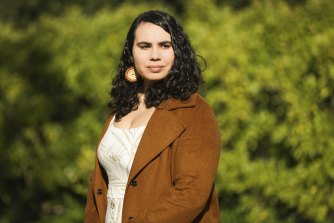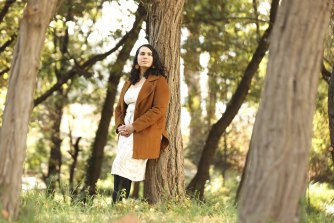Indigenous Australians are just as likely to experience eating disorders as others within the wider community but a perception the illness is only prevalent among white girls is hampering diagnosis and treatment.
The Butterfly Foundation, the national charity for eating disorders, has found one in 10 Indigenous Australians will experience an eating disorder in their lifetime and 30 per cent of Indigenous young people are concerned about body image. These figures mirror the trends of non-Indigenous Australians.
Garra Mundine is a young Indigenous woman who has recovered from two eating disorders.Credit:Alex Ellinghausen
Butterfly Foundation marketing coordinator Camilla Becket said the EveryBODY is Deadly campaign was trying to raise awareness among the Aboriginal and Torres Strait Islander communities.
“We wanted to address this pervasive stigma that eating disorders only affect privileged young white women,” Ms Becket said.
“We know that this community is affected by eating disorders and body image issues just like everybody else, but we have another sort of added layer of things like racism, discrimination, bullying, intergenerational trauma, all of these things that feed into mental health issues [like eating disorders].”
Eating disorders spiked last year across the general population amid the lockdowns for the COVID-19 pandemic. Butterfly’s national helpline logged a 45 per cent increase in demand from 2019 to 2020; demand was highest from July to October last year but is still sitting above pre-pandemic levels.
Ms Becket said the lack of awareness that eating disorders affected the Indigenous community meant individuals and their families were less likely to recognise warning signs and there were not good treatment pathways within the health system.
Everyone working on the Butterfly helpline now had cultural safety training to provide appropriate support to Indigenous people with eating disorders, she said.
It’s the type of support that Garra Mundine, 29, wishes she had in her teens and early 20s. At one point she tried to access help from an Aboriginal health service but the non-Indigenous doctor was so dismissive and “harsh” that Ms Mundine was turned off from seeking further professional help.
Garra Mundine said no one recognised that she had an eating disorder because of the perception it was for “privileged white girls”.Credit:Alex Ellinghausen
Ms Mundine, a Wiradjuri, Bundjulung, Kamilaroi and Yuin woman, was born in Dubbo but moved to Sydney when she was 11. Compared with her friends of Asian, Irish and Italian heritage, Ms Mundine’s body was more naturally curvy and she started to starve herself to fit into smaller clothes.
“In movies and everything it’s always privileged white girls so it wasn’t until I was deep into my first eating disorder that I realised there was actually a problem,” Ms Mundine said.
“I got to a small size 8 from a size 16 and nobody picked up that I wasn’t well, everyone was just saying ‘you’re losing the baby fat’ or ’you’re getting really skinny, you must be looking after yourself.”
With her parents going through a divorce, Ms Mundine felt isolated and like she needed to deal with it on her own. She eventually recovered when she went to university in Canberra.
Years later, Ms Mundine developed her second eating disorder – overeating to deal with various stressors in her life, including her mother being ill. This time she did reach out to friends and family and eventually found an Indigenous-owned gym where she felt at home.
Felicia Foxx, a Kamilaroi and Dhunghutt “sister girl” from Campbelltown and the other representative of the EveryBODY is Deadly campaign, said most black families did not discuss body image and eating disorders and this needed to change.
Butterfly Foundation National Helpline: 1800 33 4673 (ED HOPE) or www.butterfly.org.au
Start your day informed
Our Morning Edition newsletter is a curated guide to the most important and interesting stories, analysis and insights. Get it delivered to your inbox.
Most Viewed in Lifestyle
From our partners
Source: Read Full Article


